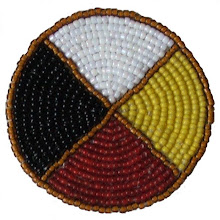
An Anishnabek Medicine Wheel, from Lillian Piktawanakwat, Birch Island
Teachings of the Wheel and Circle, and circular concepts of life, thought and spirituality, are universal to Natives in North America. The Anishnabek Medicine Wheel is used to teach a way of life and understanding, emphasizing the need for balance and harmony. Medicine wheels and the circle operate on many levels, incorporating many different elements.
The Wheel shown above is used by an Ojibwe elder from Birch Island, Ontario. The Rainbow colors are: Yellow, Red, Black, White, Blue, Green and Purple. Yellow is in the East, Red in the South, Black in the West and White in the North.
These four colours are not fixed. They depend on the teaching being given, on the personal colours of the wheel's carrier, or on traditional colours of a group. Another medicine wheel from Le Pas, Manitoba has the colours (from the East) red, green, blue and white, while the wheel from the Saskatchewan Indian Cultural Centre is yellow, blue, white and red - surrounded by green.
The four colours and four directions in each wheel are the basis of its teachings. If one of the four elements of the wheel is too strong or weak, the wheel is thrown out of balance.
Much of the imbalance in the world today stems from the inability of the four colours or races of the Medicine Wheel to recognize each other and cooperate in the circle. The mainstream perceives that Natives have wisdom when it comes to living with and preserving the land, which is true; but the Medicine Wheel, in the age of the Seventh Fire, also shows that all peoples have their own wisdom, and that the circle that is earth cannot survive unless each group shares its knowledge with the others (William Commanda). These ideas have been with the Anishnabek since long before the time of contact, but they shared them with white visitors early on. Kohl remarked, on visiting a Midewiwin lodge in 1854:
The four human figures at the sides of the sanctuary are the four great spirits sitting to the north, south, east and west... they (the Anishnabe) recognize four quarters of the world, and place a great and powerful spirit in each of them (1985: 152).
Mike Dashner is a teacher and dancer from Walpole Island. In Sound of the Drum, he gives this teaching of the Medicine Wheel:
The medicine wheel (represents) basically the message that I try to get across when I do educational outreach programs. There are four sacred colours of mankind on the planet. And... the medicine wheel is out of balance, because there's input from all three of the other races; and the Indians are just now starting to come into their responsibility to get their message out - about the environment, the greenhouse effect. But also I think that a humane kind of life is missing (in the non-Native world)... When you're there in full dance regalia, you have all these young minds just locked into everything you say - so I feel there's a real responsibility, you have to take care in the message you get across (in Cronk 1990: 21).
"The Ripple in a Pond" is a teaching from Linda Smith, at the Odawa Native Friendship Centre:
As the name implies, this circle is a series of concentric circles. The purpose of this circle is very basic. Healing is accomplished by helping the individual understand the universe and his place in it. This understanding promotes a sense of belonging. Each of the ripples is distinct and complete. However, at no time, do any of the ripples cease to be water, nor do they cease to be part of the greater picture in the pond. The circles radiate from the center in the following order: spirit, self, partner (spouse), family, extended family, community, nation, world, world views, universe/environment, spirit.
Circles, and Medicine Wheels, can also be seen to move in a spiral fashion, expanding with time. Thus, when one comes 'full circle,' it is often with increased awareness or understanding.
